i bc27f85be50b71b1 (187 page)
Read i bc27f85be50b71b1 Online
Authors: Unknown

24. Donadio J V Jr. Use of fish oil to treat paticms with immunoglobulin A
nephropathy. Am J Clin Nutr 2000;7 1 ( I ),3735.
25. Couser WG. Glomerulonephritis. Lancet 1 999;353(9 1 63), 1 509.
26. Madaio MP, Harrington JT. The diagnosis of glomerular diseases: acute
glomerulonephritis and the nephrotic syndrome. Arch Intern Med
200 ] ; 1 6 1 ( 1 ),25.
27. Wright KD. Glomerulonephritis. In K Boyden, D Olendorf (eds), Gale
Encyclopedia of Medicine. Farmington Hills. MI: Gale Group. 1 999;
1 296.
28. Orth SR, Ritz E. The nephrotic syndrome. N Engl J Med 1 998;338( 1 7),
1 202.
29. Ross JS, Shua-Haim JR. Geriatrics phoro quiz. Nephrotic syndrome.
Proteinuria characterizes this condition, and treatment targets the
underlying pathology. Geriatrics 2000;55(3),80.
30. Schaeffer AJ. What do we know about the urinary tract infection-prone
individual? J Infect Dis 200 1 ; 1 83(5):566.
3 1 . Kumar S, Beel T. NSAID-induced renal toxicity: when to suspeCt, what
to do (nonsteroidal anti-inflammatory drugs). Consultant 1 999j39( I ):
195(6).
32. Interstitial Nephritis. In WD Glanze, LE Anderson (eds), Mosby's Medical,
Nursing, and Allied Health Dictionary (5th ed). St. Louis: Mosby, 1 998;48.
33. Pak CYe. Kidney stones. Lancet 1 998;351 ( 9 1 1 8): 1 797.
34. Bernie JE, Kambo AR, Monga M. Urinary lithiasis: current treatment
options. Consultant 2000;40( 14):2340.
35. Giannini S. Nobile M, Sartori S, et 31. Acute effects of moderate dietary
protein restriction in patients with idiopathic hypercalciuria and calcium
nephrolithiasis. Am J Clin Nutr 1 999;69(2),267.
36. Diabetic nephropathy. Diabetes Care 200 I ;24( I ):569.
37. Evans TC, Capell P. Diabetic nephropathy. Clin Diabetes 2000; 1 8( I ):7.
38. Mclaughlin K, Jardine AG, Moss JG. ABC of arterial and venous disease: renal artery stenosis. BM] 2000;320(7242); 1 1 24.
39. Davidson T. Renal Vein Thrombosis. In K Boyden, D Olendorf (cds),
Galc Encyclopedia of Medicine. Farmington Hills, MI: Gale Group,
1 999;2469.

GENITOURINARY SYSTEM
603
40. Henderson LJ. Diagnosis, rrearrnenr, and lifesryle changes of inrersritial
cystitis. AORN J 2000;7 1 (3),525.
4 1 . Lamb AR. The ABCs of interstitial cystitis: a primer for midlevel providers. Physician Assistant 2000;24( 1 2),22.
42. Genitourinary System. In JM Thompson, GK McFarland, JE Hirsch, et
al. (cds), Mosby's Manual of Clinical Nursing Practice (2nd cd). St.
Loui" Mosby, 1 989; 1 086.
43. Saunders CS. Urolithiasis: new tools for diagnosis and trearmenr.
Patient Care 1 999;33( 1 5),28.
44. Gallo ML, Fallon PJ, Staskin DR. Urinary inconrinence: steps to evaluation, diagnosis, and treatmenr. Nurse Pract '1997,22(2):2 1 .
45. Epperly TD, Moore KE. Health issues i n men: part I. common genitourinary disorders. Am Fam Physician 2000j61 (12):3657.
46. Bullock BL. Disorders of Micturition and Obstructions of Genirourinary Ttact. In BL Bullock (cd), Pathophysiology, Adaptations and Alterations in Function (4th ed). Philadelphia: Lippincott, 1 996;646.
47. Bates P. Renal and Urologic Problems. In SM Lewis, MM Heitkemper,
SR Dirksen (eds), Medical-Surgical Nursing: Assessmenr and Management of Clinical Problems (5th edt. St. Loui" Mosby, 2000; 1290-1 293.
48. Ford-Marrin PA. Nephrectomy. In K Boyden, D Olendorf (eds), Gale
Encyclopedia of Medicine. Farmingron Hills, MI: Gale Group. 1999;
2040.
49. Fornara P, Doehn C, Frese R, Jocham D. Laparoscopic nephrectomy in
young-old, old-old, and oldest-old adults. J Gerontol A Bioi Sci Soc Sci
2001 ;56(5),M287.
50. Sasaki TM. Is Japaroscopic donor nephrectomy the new criterion standard? JAMA 2000;284(20),2579.
5 1 . Ford-Martin PA. Marshall-Marchetti-Kranrz Procedure. In K Boyden, D
Olendorf (cds), Gale Encyclopedia of Medicine. Farmingron Hills, MI:
Gale Group, 1999; 1 877.
52. McCallig Bates P. Sharing the secrct: talking about urinary incontinence.
Nurse Pract 2000;25( I 0): 158.
53. Dean E. Oxygen transport deficits in systcmic disease and implications
for physical therapy. Phys Ther 1 997;77(2),187.

10
Infectious Diseases
Jaime C. Paz and V. Nicole Lombard
lntroduction
A patient may be admitted to the hospital setting with an infectious
process acquired in [he community or may develop one as a complication from the hospital environment. An infectious disease process generally has a primary site of origin; however, it may result in diffuse
systemic effects that may limit the patient's functional mobility and
activity tolerance. Therefore, a basic understanding of these infectious
disease processes is useful in designing, implementing, and modifying
physical therapy treatment programs. The physical therapist may also
provide treatment for patients who have disorders resulting from
altered immunity. These disorders are mentioned in this chapter
because immune system reactions can be similar to those of infectious
disease processes (see Appendix IO-A for discussions of three common disorders of altered immunity: systemic lupus erythematosus, sarcoidosis, and amyloidosis). The objectives of this chapter are to
provide a basic understanding of the following:
'I.
Clinical evaluation of infectious diseases and altered immune
disorders, including physical examination and laboratory studies
605



606
ACUTE CARE HANDBOOK FOR I)HYSICAL lllERAlllSTS
2.
Various infectious disease processes, including etiology,
pathogenesis, clinical presentation, and management
3.
Commonly encountered altered immune disorders, includ-
ing etiology, clinical presentation, and management
4.
Precautions and guidelines that a physical therapist should
implement when treating a patient with an infectious process or
altered immunity
Definition of Terms
To facilitate the understanding of infectious disease processes, termi·
nology that is commonly used when referring to these processes is
presented in Table 10- 1 1-3
Overview of the Immune System
A person's immune system is comprised of many complex, yet syner·
gist ie, components that defend against pathogens (Table 10-2). Any
defect in this system may lead to the development of active infection.
Patients in the acute care setting often present with factors that can
create some or most of these defects, which can ultimately affect their
immune system (Table 10-3).
Evaluation
When an infectious process is suspected, a thorough patient interview
(history) and physical examination are performed to serve as a screening tool for the differential diagnosis and to help determine which laboratory tests are further required to identify a specific pathogen'
History
Potential contributing factors of the infection are sought out, such as
exposure to infectious individuals or recent travel to foreign coun·
tries. Also, a qualitative description of the symptOmatology is discerned, sllch as onset or nature of symptoms (e.g., a nonproductive versus productive cough over the past day or weeks).


